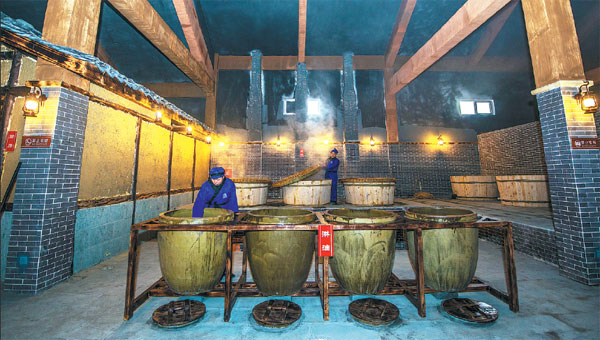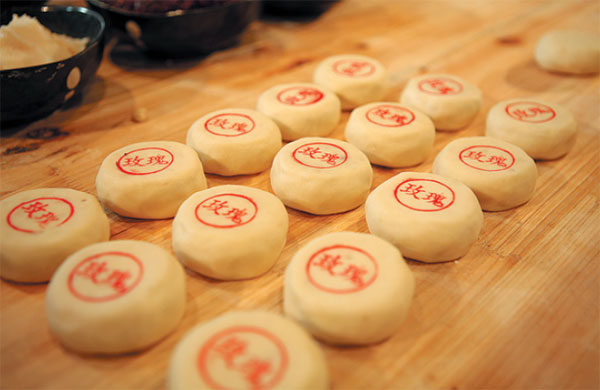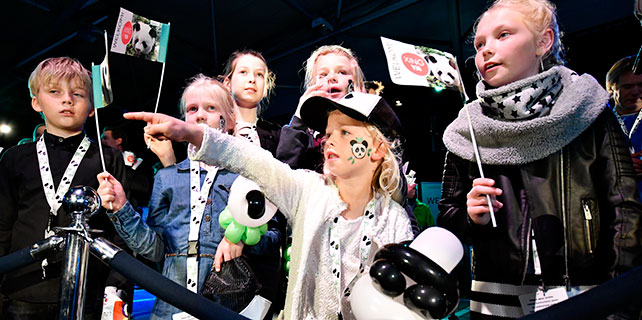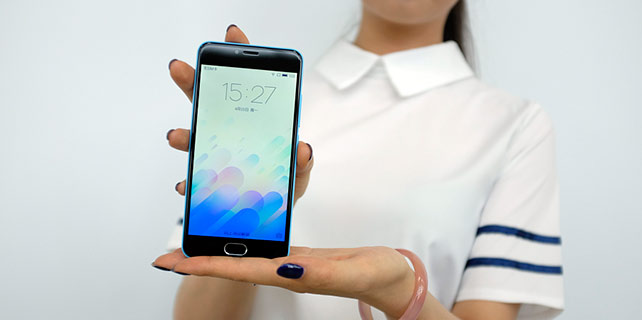Guards of honor
In many cases they have built their reputations over hundreds of years, and they have become names that millions of Chinese love, respect and most of all buy
At least once a year Meng Wei visits several shops in Beijing that specialize in traditional goods, looking to buy something for his family in Xi'an.
"It's a routine I go through before I head home for big holidays such as Spring Festival," Meng says.
Among the perennials on his shopping list are Daoxiangcun pastries and Niulanshan erguotou, a 65 proof white spirit made in Beijing.
|
Some of the Chinese time-honored brands that have been bywords for older generations faded from view but have then made spectacular comebacks. Photos Provided to China Daily |
"My mother has a sweet tooth and she always has a craving for Daoxiangcun, and my uncles love the kick of erguotou," Meng says.
A trust in quality and a hankering for things of the past are among the reasons why many people buy these time-honored brands.
"Time-honored brands" refers to old products, techniques or services that are unique in a particular way and enjoy an excellent reputation and culture cachet, says Zheng Wen, head of the Ministry of Commerce's circulation development division.
However, with such brands one characteristic stands out above all else: Their popularity has endured for years, decades and in many cases centuries.
That popularity was evident in the attention the public gave to them in a survey of time-honored brands in Beijing last year, which drew more than 4 million respondents.
Yili, a century-old pastry brand, came out on top as the favorite. There are some old brands, too, that have been bywords for older generations, faded from view but then made spectacular comebacks.
One of these is Beibingyang (Arctic Ocean) a soft drink that was the first commercial beverage many Beijingers tasted. It disappeared from the market for 15 years but resurfaced in 2010. It again proved to be a hit, many people saying it took them back to the 1960s and 1970s, and was a natural reference point as older people started recounting childhood stories to their children.
"Such brands are the product of market competition and real quality," says Yin Jie, an official with a committee of experts charged with revitalizing Chinese time-honored brands.
These brands are 230 years old on average, and some were highly popular back when the country enjoyed great prosperity hundreds of years ago, Yin says.
"To this day what China contributes to these brands is certain rare natural ingredients, and that keeps them going."

A guardian of one Chinese time-honored brand is Yin Zhiqiang. However, the day China Daily visited him on duty he looked more like a decontamination expert than a guard, wearing a face mask and dressed in a blue gown that covered most of his upper body. He was teaching apprentices about the process of making ink, and some of the methods he uses are as old as Yidege, the company he works for, which celebrated its 150th anniversary two years ago.
Despite the protection, Yin is not going to be spared the attention of the black ink he is making, because the carbon used in making it needs to be poured into a glue substance, and some particles inevitably will be carried through the air as this is being done, he says.
"However, we used to get really dirty - much dirtier than if you shake the egg-shaped briquette," Yin says.
For more than 30 years he did a lot of physically demanding work that has been eased thanks to modern technology, he says.
"Now at least we don't need to mix a huge mass of mortar by hand."
However, a lot still needs to be done manually, the old fashioned way, he says.
Every day, 21 bags of solid glue need to be lifted by hand and poured into a big vessel to be dissolved.
Another important step in production that even modern technology seems incapable of providing ready help for is heat control.
The ink glue is in an optimum state in a very short time frame after about four hours' heating, and removing it from the heat too soon or too late can ruin the glue, so the whole exercise demands a huge amount of experience, Yin says.
"You have to stand watch over the pot for the duration of the long process."

It is this devotion to ensuring everything is just right that has contributed to the ink brand's quality and enduring renown.
"Our ink is thick and shiny, and is highly water resistant," Yin says.
Xie Songdai of Hunan province created the first Yidege calligraphy ink in 1865. Until then, Chinese had used natural graphite for writing since the Yin-Shang Period (1600-1046 BC).
All ink was derived from this solid block, which was grounded with the help of water, before the resulting liquid was applied to the brush. Xie saw this process as irksome and time wasting, especially for those sitting imperial exams.
After trial and error he settled on lampblack and a few other auxiliary materials and finally came up with the liquid ink.
He opened the first Yidege shop in Beijing in 1865, and before long the business expanded to Tianjin, Shanghai, Xi'an and Zhengzhou, Henan province.
Almost all calligraphers in modern times have used Yidege's liquid ink, and it was named a Chinese time-honored brand in 2006. Its ink-making technique was named a national intangible cultural heritage in 2014.
The ink dries quickly and has a fragrance - the result of traditional Chinese medicine ingredients such as borneol and musk being added - that many aficionados appreciate.
Just as Yidege ink has become a must-have for calligraphers, Juancheng Pixian Thick Broad-Bean Sauce has become a must-have ingredient for those who are preparing Sichuan food.
On the outskirts of Chengdu, Sichuan province, hundreds of giant dark brown porcelain pots lie next to one another in an open-air square at the Juancheng Pixian Thick Broad-Bean Sauce factory.
Broad beans with other ingredients are fermenting in the sun, and they will eventually turn into the Pixian thick broad-bean sauce that is a vital ingredient of many Sichuan dishes.
Zhang Anqiu, 56, takes the lid off a pot to check the fermentation.
This is a daily ritual, and all pots need constant attention, Zhang says.
The mixture needs to be exposed to the sun, covered when it rains, exposed to dew by night and be covered again for some time to retain the dampness.
All the handling is manual.
Pixan was named a Chinese time-honored in 1988, 300 years after it was first made. It is said to have been a creation of happenstance when a man named Chen Yijian took broad beans with him as his family migrated from Fujian province to Pixian county in Sichuan.
The beans became mildewed on the way, but Chen was reluctant to throw them away. He sundried them and mixed them with fresh pepper before fermenting them for several days. To his surprise, the beans were delicious.
After generations of refinement, it seems that few Sichuan dishes would be worthy of their name without at least a dash of Pixian sauce, and can easily elevate a dish with its spicy, lingering mellow flavor.
However, preparing the mixture before it is put into the fermenting pot is anything but easy, requiring extremely delicate handling and timing. The experts say it is vital to get the proportion of bacteria-carrying flour and water exactly right. Boiled beans are subsequently added to the flour-water mixture and put into the pot.
"If too much flour has been used it will slow down the growth of bacteria, and too much water will cause the bacteria to die and lead to black mould," Zhang says.
After everything is in pot, the hard work continues.
The contents of the pot need to be turned over from time to time during the fermentation process, Zhang says.
"To what extent you stir the mixture depends on the intensity of sunshine, and how often you do it depends on how mature the surface sauce has become. Once a layer matures it needs to be turned over."
Zhang has worked as a local broad-bean sauce maker for 40 years and was named a non-tangible cultural heritage inheritor by Sichuan in 2009.
He developed a water-bathheat-preservation fermentation method that shortens production time to 60 days - it used to be as long as one year - and reduces the impact of seasonal changes.
As a result, the company now produces 24,800 metric tons of sauce a year. The sauce can be found on shop shelves in North America, Japan and Germany.
Appealing to a totally different taste is Daoxiangcun traditional bakery in Suzhou, Jiangsu province.
It was founded in 1773, and the emperor Qianlong of the Qing Dynasty (1644-1911) became a devotee when he took a trip in regions south of the Yangtze River.
The brand was still popular in the early Minguo period (1912-49), when cakes and sweetmeats, roasted nuts and preserved fruits were available, with moon cakes being the most well-known of all. Daoxiangcun then set up shop in dozens of northern cities.
In a Chinese brand value evaluation by the China Council for Brand Development last year, the brand was said to be worth more than 11.2 billion yuan ($1.61 billion), giving it seventh ranking.
Quality ingredients are key to the popularity of the brand in China.
Walnuts are generally chosen from Fenyang, Shanxi province, because of their thin skin and lack of bitterness. Rose petals mostly from Miaofeng Mountain in Beijing are favored because of their rich aromatic flavor and high rose oil content.
The stuffing, made of black sesame, sweet-scented osmanthus, hawthorn, and nuts and cream are all from well-known factories and are inspected twice manually, a spokesman for Beijing Daoxiangcun says.
Any eggs used must be no more than three days old, and traditional production techniques have been retained.
The company's sweet dumpling yuanxiao, a traditional snack usually consumed during Lantern Festival, is made in accordance with time-worn traditions, and the yuanxiao powder is ground by stone mills to ensure the mixture is fine and smooth.
The recipe for the brand's honey cake is said to strictly follow the original, featuring chewy flour powder, fresh eggs and pure honey, with artificial ingredients as emulsifier.
However, in addition to traditional preservation, Daoxiangcun says it has moved with the times and introduced standard modern design, strict hygiene and highly developed automation to ensure quality.
The company says it had turnover of 2.5 billion yuan last year, and that its sales have grown 30 percent for each of the past three years.
Daoxiangcun now has its eyes on overseas markets and has set up a foreign trade department for Canada.
yangfeiyue@chinadaily.com.cn
|
A worker prepares cooking sauce for the traditional condiment maker Qingxiangyuan. Provided to China Daily |
|
Rose cakes of the time-honored Chinese pastry maker Daoxiangcun. Provided to China Daily |
(China Daily 04/15/2017 page13)

























